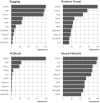Predicting student self-efficacy in Muslim societies using machine learning algorithms
- PMID: 39735162
- PMCID: PMC11672345
- DOI: 10.3389/fdata.2024.1449572
Predicting student self-efficacy in Muslim societies using machine learning algorithms
Abstract
Introduction: Self-efficacy is a critical determinant of students' academic success and overall life outcomes. Despite its recognized importance, research on predictors of self-efficacy using machine learning models remains limited, particularly within Muslim societies. This study addresses this gap by leveraging advanced machine learning techniques to analyze key factors influencing students' self-efficacy.
Methods: An empirical dataset collected was used to examine self-efficacy among secondary school students in Muslim societies. Four machine learning algorithms-Decision Tree, Random Forest, XGBoost, and Neural Network-were employed to predict self-efficacy using two demographic variables and 10 socio-emotional, cognitive, and regulatory factors. The predictors included culturally relevant variables such as religious/spiritual beliefs and collectivist-individualist orientation. Model performance was assessed using root mean square error (RMSE) and r-squared (R 2) metrics to ensure reliability and validity.
Results: The results showed that Random Forest outperformed the other models in accuracy, as measured by R 2 and RMSE metrics. Among the predictors, self-regulation, problem-solving, and a sense of belonging emerged as the most significant factors, contributing to more than half of the model's predictive power. Other variables such as gratitude, forgiveness, empathy, and meaning-making displayed moderate predictive value, while gender, emotion regulation, and collectivist-individualist orientation had minimal impact. Notably, religious/spiritual beliefs and regional factors showed negligible influence on self-efficacy predictions.
Discussion: This study enhances the understanding of factors influencing self-efficacy among students in Muslim societies and offers a data-driven foundation for developing targeted educational interventions. The findings highlight the utility of machine learning in education research, demonstrating its ability to uncover insights for equitable and effective decision-making. By emphasizing the importance of regulatory and socio-emotional factors, this research provides actionable insights to elevate student performance and well-being in diverse cultural contexts.
Keywords: Muslim societies; academic performance; educational equity; machine learning; self-efficacy; self-regulation; socio-emotional learning; student wellbeing.
Copyright © 2024 Ba-Aoum, Alrezq, Datta and Triantis.
Conflict of interest statement
The authors declare that the research was conducted in the absence of any commercial or financial relationships that could be construed as a potential conflict of interest.
Figures






Similar articles
-
Identifying determinants of malnutrition in under-five children in Bangladesh: insights from the BDHS-2022 cross-sectional study.Sci Rep. 2025 Apr 24;15(1):14336. doi: 10.1038/s41598-025-99288-y. Sci Rep. 2025. PMID: 40274916 Free PMC article.
-
AI-driven educational transformation in ICT: Improving adaptability, sentiment, and academic performance with advanced machine learning.PLoS One. 2025 May 19;20(5):e0317519. doi: 10.1371/journal.pone.0317519. eCollection 2025. PLoS One. 2025. PMID: 40388422 Free PMC article.
-
Mental health analysis of international students using machine learning techniques.PLoS One. 2024 Jun 6;19(6):e0304132. doi: 10.1371/journal.pone.0304132. eCollection 2024. PLoS One. 2024. PMID: 38843140 Free PMC article.
-
Assessment and Evaluation of Different Machine Learning Algorithms for Predicting Student Performance.Comput Intell Neurosci. 2022 May 9;2022:4151487. doi: 10.1155/2022/4151487. eCollection 2022. Comput Intell Neurosci. 2022. PMID: 35586111 Free PMC article.
-
Integrating artificial intelligence to assess emotions in learning environments: a systematic literature review.Front Psychol. 2024 Jun 19;15:1387089. doi: 10.3389/fpsyg.2024.1387089. eCollection 2024. Front Psychol. 2024. PMID: 38966729 Free PMC article.
References
-
- Abu-Nimer M., Nasser I. (2017). Building peace education in the Islamic educational context. Int. Rev. Educ. 63, 153–167. 10.1007/s11159-017-9632-7 - DOI
-
- Allen K., Kern M. L., Vella-Brodrick D., Hattie J., Waters L. (2018). What schools need to know about fostering school belonging: a meta-analysis. Educ. Psychol. Rev. 30, 1–34. 10.1007/s10648-016-9389-8 - DOI
-
- Al-Nammari R., Simsekler M. C. E., Gabor A. E., Qazi A. (2023). Exploring drivers of staff engagement in healthcare organizations using tree-based machine learning algorithms. IEEE Trans. Eng. Manag. 70, 2988–2997. 10.1109/TEM.2022.3209879 - DOI
-
- Araz O. M., Olson D., Ramirez-Nafarrate A. (2019). Predictive analytics for hospital admissions from the emergency department using triage information. Int. J. Prod. Econ. 208, 199–207. 10.1016/j.ijpe.2018.11.024 - DOI
-
- Asselman A., Khaldi M., Aammou S. (2021). Enhancing the prediction of student performance based on the machine learning XGBoost algorithm. Interact. Learn. Environ. 31, 3360–3379. 10.1080/10494820.2021.1928235 - DOI
LinkOut - more resources
Full Text Sources
Miscellaneous

